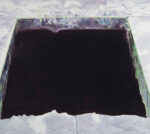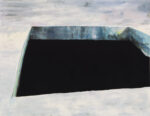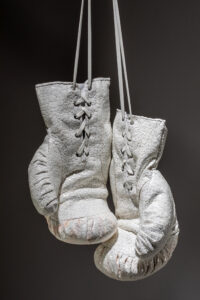WHAT HAVE WE STUMBLED UPON here at the edge of the woods? Hard to know if it’s early or late—the light is so strange. How long has he hung here like this?
The air is still, with the kind of stillness that comes just after something has happened, after someone has left. Your senses are attuned, or perhaps attuning still.
There’s something else at play too.
You can’t quite believe your eyes. Look past the surface: There’s another surface. What you see suspended before you is transformation itself.
Francisco de Zurbarán’s The Martyrdom of Saint Serapion (1628) is a multiplex system—a convergence of sensory and sacred forces into what is both a tender portrait of the martyred monk and a poetic meditation on the process of painting.
Zurbarán elevates plain truth past the mundane, suspending life and death by the threads of his close observation. That which is seen becomes sacred. In turn, our own scrutiny of the scene is rewarded with intimate access to the threshold between fact and faith. For all its fullness, Saint Serapion is an image of profound restraint.
In 1628, Zurbarán, Spain’s most prominent painter after Velázquez, secured a lucrative commission for a cycle of religious paintings for the monastery of Casa Grande de la Merced Calzada in Seville. He was asked to paint “that which is fitting,” and the contract was generous: In addition to his fee, the artist and his assistants received room and board for the better part of a year and materials of “exceptional quality.”
A devout Catholic, the thirty-year-old Zurbarán had already discovered a channel for his deeply held personal beliefs. The sensibility that permeated his paintings aligned with the Counter-Reformation’s emphasis on piety, devotion, and intense spiritual experience, and he infused his preferred subjects with a spare realism. Now, with an opportunity to live among monks, Zurbarán immersed himself in their way of life. He would never paint for the court as Velázquez had. The Mercedarian monks, at once his patrons and subjects, became his solemn collaborators.
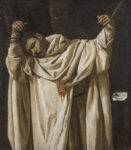
Francisco de Zurbarán. The Martyrdom of Saint Serapion, 1628. Oil on canvas. 47¼ x 41 inches. Wadsworth Atheneum, Ella Gallup Sumner and Mary Catlin Sumner Collection Fund. Photo: Allen Phillips.
An artist’s solitary toil often elicits comparison with the life of a cloistered monk, as both vocations navigate between isolation and communion. Monks, for their part, choose a life devoted to something larger than themselves and rarely live apart from their brethren. Indeed, even orders that practice silence do so together, evolving their own subtle nonverbal languages. The respective callings of the artist and the monk, perhaps then as now, stand in stark contrast to the world at large.
One of the final paintings in the Mercedarian commission, the recently restored Saint Serapion now finds its home at the Wadsworth Atheneum in Hartford, Connecticut. A treasure of the museum’s seventeenth-century collection, the painting—just under four feet high—meditates on both the painter’s chosen subject and his medium.
Originally placed in the monastery’s newly completed chapter house, where monks gathered to mourn their dead, the painting hung above the funeral bier—a poignant reminder of sacrifice.
The order of Mercedarian monks, legendary for selfless acts, exists to this day. It was formed in 1218 to free Christians held captive by Moorish armies, its members trading their own bodies for the enslaved and imprisoned. Serapion, thought to have been born somewhere in the British Isles in the twelfth century, is known to have marched with the army of Richard the Lionhearted and later joined the Christian reconquest of Spain. He is believed to have rescued several hostages before his eventual capture in Scotland by English pirates while on a mission to found a monastery. When the ransom for his release was delayed, he was tortured on a diagonal cross in the manner of Saint Andrew, dismembered, and beheaded.
The friars at the monastery in Seville might have seen the austerity of their chosen lifestyle validated in the factual simplicity of Zurbarán’s painting. Those who saw the artist at work may have witnessed the conversion of pigment into flesh, light into sanctity. In his Caravaggistic plan, candlelight in the darkened chamber animated Serapion’s robes, if only in the minds of the viewers.
Catholic liturgy is replete with substances: oil, ash, water, wine, bread. Each undergoes a transformation through blessing and consecration. Wine and bread are transubstantiated into the blood and body of Christ. A painter of martyrdom would appear to perform similar wonders. In fact, the working habits of many painters might resemble liturgical rubrics. Oils, pigments, solvents, rags, and brushes: Each object may be laid out in a personal choreography as codified as any mass, only messier. And Zurbarán’s studio, after all, was essentially a chapel.
The painter’s materials were themselves rich with symbolic weight: Pigments from mineral oxides, bone, ivory, lead, and gemstones were finely ground and mixed with linseed oil from the flax plant, also the source of both the linen canvas and Serapion’s robes. Because I’m always trying to imbue my landscapes with a human element, I was intrigued to learn that the glycerol in linseed oil is identical to the glycerol in our bodies. Linseed oil is the binder that gives paint weight and body and bonds it to the canvas. More linseed oil is combined with turpentine to make a medium for mixing the paint on the palette. This turpentine thinner, tellingly known as spirits, evaporates with no trace and helps the oil paint achieve mysterious lifelike qualities.
Meanwhile, Zurbarán’s earthen palette and austere composition anchor Serapion to this world. A simultaneously real and miraculous light elevates the tortured saint beyond the pain he has endured and, for a moment, holds the coming darkness at bay.
The coarse linen robes glow, but not from any earthly light. It’s the painter’s sensitive tenebrism—the shadows rather than the color—that renders the emotion. The  saint’s jaw slackens in the crook of his elbow. His limp hands are bound to the young trees behind him. The pallor of his skin has already transitioned to an earthen tone.
saint’s jaw slackens in the crook of his elbow. His limp hands are bound to the young trees behind him. The pallor of his skin has already transitioned to an earthen tone.
These bodily details move the saint—and, by extension, us—toward an in-between state, prompting another question. I missed it at first, but it’s too deliberate to be a mistake: Why is his ear placed so unnaturally high on his head? Such awkward positioning directs our attention to hearing, the final sense to fade with death. Sound becomes central to the hushed scene. In that moment of realization, we might feel united with the dying monk, suspended together in a sort of terminal lucidity.
Zurbarán stages our encounter so that we’ll see what he saw, but he also invites us to listen. In the exaggerated helix of Serapion’s ear, a pareidolic form emerges—odd, yet as deliberately painted as the rest of the face: It’s hard not to see the Virgin Mary’s unmistakable custodial shape. Zurbarán’s subtle and, I believe, intentional inclusion suggests that the Virgin—patroness of the Mercedarian order—whispers to the dying monk in a final gesture of grace.
Multiple portraits, seen and unseen, reside within this painting. They emerge through a sequence of doublings: light and shadow, cloak and canvas, martyr and maker. The greater part of the prepared linen is given over to a representation of draped fabric—a painter’s rumination on materiality, surface, suspension, and sacrifice. The drapery hangs. The saint hangs. The paint hangs. The object hangs. Time hangs. All to momentarily suspend our disbelief.
When I first looked closely at the Zurbarán, I was in need of guidance in my own painting. In Saint Serapion, I recognized something—unnamable at the time—that I can now describe as a kind of in-betweenness, a mysterious state I also hope to achieve in my work.
The Wadsworth is a museum I visit frequently, and I’ve admired Saint Serapion for many years. On the day of this encounter, I circled back to it several times, hardly knowing why. Then it occurred to me: I’m also a painter of shrouds, though mine are not hanging robes but blankets of snow and ice. From the winter-white expanses of frozen lakes and rivers in Maine and Vermont, using six-foot saws and heavy picks left over from the bygone ice-harvesting trade, I cut and remove blocks of ice. A dark trapezoid remains. Its coloration shifts widely, taking on the qualities of ink, velvet, oil, blood, even automotive antifreeze.
I tend to think in opposites, and for a painter that’s a good thing—painting is often a construction of conflict and contradiction. In that sense, the hole pictured on my canvases is the via negativa: a way of describing something—God, for instance—by addressing what it is not.
I’m not sure whether my hole in the ice is an entrance to oblivion, as some have suggested, noting its tomb-like qualities. Mostly I like that it oscillates between the material of the paint, the representation of a hole in the ice, and a simple shape. It’s an unexpected way to think about and observe the world, one that, in painting as in reality, defers ultimately to a mysterious and inescapable vanishing point.
X-rays from museum conservation efforts in 2015 reveal the wooden armature beneath Zurbarán’s painting: a rectangular stretcher reinforced with a vertical bar and two horizontals—an accidental cruciform. Zurbarán’s assistants would have stretched the rough linen canvas over a similar structure, affixing it with iron tacks not unlike the nails driven into Christ’s flesh. Whoever prepared the original surface in the monastic atelier might have recognized the uncanny parity between workshop and worship.
In keeping with the austerity of his subjects, Zurbarán’s palette, though made from fine pigments, was in a sense impoverished in that he limited the color range. A restricted palette also established a distinction between the earthly scene and the purity of otherworldly light across the coarse cloak. This is a picture of restraint, after all.
Zurbarán’s decision to mute his colors gives his one chromatic gesture extraordinary gravity. Pinned to the martyr’s chest, at the painting’s center, is the insignia of his order: a white Templar cross on a vermilion field. The venerated symbol—of purity and a violent end—rests askew above Serapion’s heart.
Zurbarán understood that it’s often not color that touches our hearts so much as the movement of light and shadow across believable form. Shadows, of course, emphasize light’s undeniable physical presence. Even so, Serapion appears irradiated by a light less optical than it is theological.
In Zurbarán’s hands, tenebrism isn’t for the sake of drama but rather strives for a sort of theology of sight. In the case of the brutally tortured Serapion, the painter chooses to spare us a graphic rendering of his punishment. We see nothing of his body, save for a hint of what should be his flayed and bloodied torso. As with other
aspects of this picture, close looking reveals another surface. Through a gap in his cloak, we see instead an undergarment bundled and cinctured like a harvest sheaf—perhaps of flax, a symbol of purity and righteousness and also the material from which both canvas and garment are made. Our saint’s disconnected head and bound hands, as in the still lifes or natura mortua at which Zurbarán excelled, rest upon his cloak like objects on a table. The cloak is a hanging bolt of fabric: a white square set within a darkened square.
Our twenty-first-century eyes insist on seeing this shape-within-a-shape as a prefiguring abstraction. Nearly three centuries after Zurbarán, Ukrainian-born, Catholic-raised Kazimir Malevich would arrange a white square off-center within a black one, a so-called Suprematist composition—a different credo from Zurbarán’s, for sure, but one with a similarly transcendent ambition.
To the right of the martyr’s pleated cloak, a small rectangular card—a cartellino—is pinned to a tree: another hanging element to remind us again of Zurbarán’s 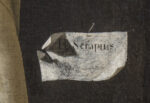 deceptive powers. A brighter, colder light than elsewhere reveals that the paper has been handled. It’s a little dirty. A torn edge rises in the painting’s brightest light. Lifted, ironically, by the density of a pure lead white, it casts an angled shadow.
deceptive powers. A brighter, colder light than elsewhere reveals that the paper has been handled. It’s a little dirty. A torn edge rises in the painting’s brightest light. Lifted, ironically, by the density of a pure lead white, it casts an angled shadow.
It’s a sort of calling card, a label, maybe an aide-mémoire, lest we forget what we’ve witnessed. Similar elements appear frequently in Zurbarán’s works, and one cannot fail to notice their curious resemblance to today’s museum labels.
On it, the name of the martyr: B. Serapius. English-speaking viewers may read the letter B as the verb be in the imperative. I wonder if Zurbarán intended this as a nod to Serapion’s native tongue. A deliberate linguistic puzzle spanning centuries is probably too much to wish for, yet the implied command—“You, be Serapius”—strikes the heart.
Indeed, for the brief time we commune with Zurbarán’s portrait, we are bound together, united. We’re made better for it too. This is the magic of painting, through which substantive, physical form is transposed into light and shadow, finally concluding in transcendence—the evaporation of the self into selflessness.
The trompe l’oeil B, of course, stands for the Latin honorific Benedictus: Blessed Serapius. And below, the signature of the man who rendered his image. There they are, a saint and a painter, transubstantiators both, one above, one below.
A tarnished silver pin recalls the delicate present, holding these many overlapping realities in place a while longer.
Eric Aho’s paintings appear courtesy of the artist and DC Moore Gallery, New York. Ice Cut (Violet Kennebec): collection of the Farnsworth Art Museum, Rockland, ME; Lynne Drexler Acquisition Fund. Ice Cut (1933): collection of the Buffalo AKG Art Museum, NY; George B. & Jenny R. Mathews Fund. Photos: Rachel Portesi.
Eric Aho is an American painter represented by DC Moore Gallery in New York. He lives and works in Vermont and, from time to time, writes about looking at art and about the natural world. Rizzoli Electa will publish the first monograph on his painting in the fall of 2026.




